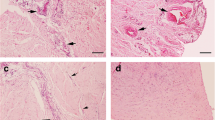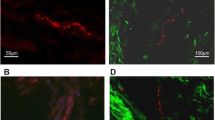Abstract
Introduction
The purpose of the study was to determine the distribution and number of nerves inside the infrapatellar fat pad and the adjacent synovium, in particular with regards to nociceptive substance-P nerves.
Materials and methods
The infrapatellar fat pad of the knee was resected from 21 patients (4 male, 17 female, mean age 69 years) during the course of standard total knee arthroplasty operations performed in our clinic. The fat pad was dissected into five standardized segments, fixed in formalin and embedded in paraffin. Immunohistochemical techniques using antibodies against S-100 protein and substance-P (SP) were employed to determine and specify the nerves.
Results
Studying all the detectable nerves present in 50 observation fields (200-fold magnification), we found an average of 106 S-100 versus 25 SP nerves (24%) in the synovium and 27 S-100- versus 7 SP nerves (26%) in the interior of the fat pad. The total nerve count was significantly ( P <0.001) higher in the synovium than in the fat pad for both marker types. The number of S-100 nerves was significantly ( P <0.05) higher in the central and lateral segments of the fat pad, while SP nerves were equally distributed throughout all segments of the fat-pad. SP nerves were significantly more frequently associated with blood vessels inside the fat pad (43%, P <0.05) than in the synovial tissue (28%).
Conclusion
The occurrence and distribution of SP nerves inside the infrapatellar fat pad suggest a nociceptive function and a neurohistological role in anterior knee pain syndrome. The data support the hypothesis that a neurogenous infection of the infrapatellar fat pad could contribute to anterior knee pain syndrome.




Similar content being viewed by others
References
Apostolaki E, Cassar-Pullicino VN, Tyrrell PNM, McCall IW (1999) MRI appearences of the infrapatellar fat pad in occult traumatic patellar dislocation. Clin Radiol 54:743–747
Barrack RL, Skinner HB, Buckley SL (1989) Propriozeption in the anterior cruciate deficient knee. Am J Sports Med 17:1–6
Bentley G (1989) Anterior knee pain: diagnosis and management. J R Coll Surg Edinb 34:2–3
Biedert RM, Stauffer E, Friedrich NF (1992) Occurrence of free nerve endings in the soft tissue of the knee joint. A histological investigation. Am J Sports Med 20:430–433
Biedert RM, Sanchis-Alfonso V (2002) Sources of anterior knee pain. Clin Sports Med 21:335–347
Boyd IA (1954) The histological structure of the receptors in the knee joint of the cat correlated with their physiological response. J Physiol 124:476–488
Buma P, Elmans L, Van den Berg WB, Schrama LH (2000) Neurovascular plasticity in the knee joint of an arthritic mouse model. Anat Rec 260:51–61
Colpaert FC, Donnerer J, Lembeck F (1983) Effects of capsaicin on inflammation and on substance P content of nervous tissues in rats with adjuvant arthritis. Life Sci 32:1827–1834
Dionne RA, Max MB, Gordon SM, Prada S, Sang C, Gracely RH, Sethana NF, MacLean DB (1998) The substance-P receptor antagonist CP-99, 994 reduces acute postoperative pain. Clin Pharmacol 64:562–568
Dye SF, Vaupel GL, Dye CC (1998) Conscious neurosensory mapping of the internal structures of the human knee without intra-articular anesthesia. Am J Sports Med 26:733–777
Euler US, Gaddum JH (1931) An unidentified depressor substance in certain tissue extracts. J Physiol 72:74–87
Faletti C, De Stefano N, Giudice G, Larciprete M (1998) Knee impingement syndromes. Eur J Radiol 27:60–69
Freeman MAR, Wyke B (1967) The innervation of the knee joint. An anatomical and histological study in the cat. J Anat 101:505–532
Fulkerson JP (1998) Evaluation of the peripatellar soft tissues and retinaculum in patients with patellofemoral pain. Clin Sports Med 8:197–202
Gardner E (1944) The distribution and termination of nerves in the knee joint of the cat. J Comp Neurol 80:11–32
Garrick JG (1989) Anterior knee pain (chondromalacia patella). Phys Sportsmed 17:75–84
Gazelius B, Edwall B, Olgart L, Lundberg JM, Hökfelt T, Fischer JA (1987) Vasodilatatory effects and coexistence of calcitonin gene-related peptide (CGRP) and substance P in sensory nerves of cat dental pulp. Acta Physiol Scand 130:33–40
Grübner J, Wolter D, Lierse W (1986) Der vordere Kreuzbandreflex (LCA-Reflex). Unfallchirurg 89:551–554
Harrison S, Geppetti P (2001) Substance P. IJBCB 33:555–576
Hoffa A (1904) The influence of the adipose tissue with regard to the pathology of the knee joint. JAMA 43:795–796
Jacobson KE, Flandry FC (1989) Diagnosis of anterior knee pain. Clin Sports Med 8:179–195
Jacobson JA, Lenchik L, Ruhoy MK, Schweitzer ME, Resnick D (1997) MR imaging of the infrapatellar fat pad of hoffa. RadioGraphics 17:675–691
James SL (1979) Chondromalacia of the patella in the adolescent. In: Kennedy JC (ed) The injured adolescent knee. Williams & Wilkins, Baltimore, pp 205–251
Kennedy JC, Weinberg HW, Wilson AS (1974) The anatomy and function of the anterior cruciate ligament. J Bone Joint Surg 56-A:223–235
Kennedy JC, Alexander IJ, Hayes KC (1982) Nerve supply of the human knee and its functional importance. Am J Sports Med 10:329–335
Lembeck F, Folkers K, Donnerer J (1981) Analgesic effect of antagonists of substance-P. Biochem Biophys Res Commun 103:1318–1321
Levine JD, Clark R, Devor M, Helms C, Moskowitz MA, Basbaum AI (1984) Intraneuronal substance P contributes to the severity of experimental arthritis. Science 226:547–549
Magi M, Barca A, Bucca C, Langerance V (1991) Hoffa disease. Ital J Orthop Traumatol 17:211–216
Malcangio M, Garrett NE, Cruwys S, Tomlinson DR (1997) Nerve growth factor- and neurotrophin-3-induced changes in nociceptive threshold and the release of substance P from the rat isolated spinal cord. J Neurosci 17:8459–8467
Malcangio M, Bowery NG (1999) Peptide autoreceptors: does an autoreceptor for substance-P exist? Trends Pharmacol Sci 20:405–407
Malek MM, Mangine RE (1981) Patellofemoral pain syndromes: a comprehensive and conservative approach. Orthop Sports Phys Ther 2:108–116
Ogilvie-Harris DJ, Giddens J (1994) Hoffa’s disease: arthroscopic resection of the infrapatellar fat pad. Arthroscopy 10:184–187
Post WR, Fulkerson JP (1993) Anterior knee pain—a symptom not a diagnosis. Bull Rheum Dis 42:5–7
Reid DC (1993) The myth, mystic and frustration of anterior knee pain (editorial). Clin J Sports Med 3:139–143
Ruffin MT, Kiningham RB (1993) Anterior knee pain: the challenge of patellofemoral syndrome. Am Fam Physician 47:185–194
Sanchis-Alfonso V, Rosello-Sastre E, Monteagudo-Castro C, Esquerdo J (1998) Quantitative analysis of nerve changes in the lateral retinaculum in patients with isolated symptomatic patellofemoral malalignment. Am J Sports Med 26:703–709
Sanchis-Alfonso V, Rosello-Sastre E (2000) Immunohistological analysis for neural markers of the lateral retinaculum in patients with isolated symptomatic patellofemoral malalignment. A neuroanatomic basis for anterior knee pain in the active young patient. Am J Sports Med 28:725–731
Sanchis-Alfonso V, Rosello-Sastre E (2003) Anterior knee pain in the young patient—what causes the pain? “Neural model”. Acta Orthop Scand 74:697–703
Sandow MJ, Goodfellow JW (1985) The natural history of anterior knee pain in adolescents. J Bone Joint Surg 67-B:36–38
Walsh DA, Salmon M, Mapp I, Garrett N, Blake D, Polak J (1994) Microvascular substance-P binding to normal and inflamed rat and human synovium. J Pharmacol Exp Ther 267:951–960
White D, Helme R (1985) Release of substance-P from peripheral nerve terminals following electrical stimulation of the sciatic nerve. Brain Res 336:27–31
Witonski D, Wagrowska-Danielewicz M (1999) Distribution of substance-P nerve fibers in the knee joint in patients with anterior knee pain syndrome. Knee Surg Sports Traumatol Arthrosc 7:177–183
Wojtys EM, Beaman DN, Glover RA, Janda D (1990) Innervation of human knee joint by substance-P fibers. Arthroscopy 6:254–263
Xie Y, Zhang J, Petersen M, La Motte RH (1995) Functional changes in dorsal root ganglion cells after chronic nerve constriction in the rat. J Neurophysiol 73:1811–1820
Yoshida H, Fujita S, Nishida M, Iizuka T (1999) The expression of substance P in human temporomandibular joint samples: an immunohistochemical study. J Oral Rehab 26:338–344
Author information
Authors and Affiliations
Corresponding author
Rights and permissions
About this article
Cite this article
Bohnsack, M., Meier, F., Walter, G.F. et al. Distribution of substance-P nerves inside the infrapatellar fat pad and the adjacent synovial tissue: a neurohistological approach to anterior knee pain syndrome. Arch Orthop Trauma Surg 125, 592–597 (2005). https://doi.org/10.1007/s00402-005-0796-4
Received:
Published:
Issue Date:
DOI: https://doi.org/10.1007/s00402-005-0796-4




